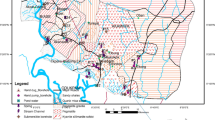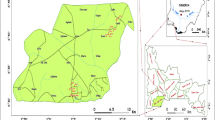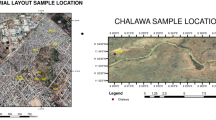Abstract
The study area is underlain by igneous intrusives and shales of the Asu River Group (Albian) in the southern Benue Trough, Nigeria. The massive mining operations in the Oshiri–Ishiagu mining axis have necessitated investigation of effects of mining works on water resources in the adjoining areas. Assessment of water resources around the study area was carried out to ascertain concentrations of trace elements/heavy metals using atomic absorption spectrophotometer. Results revealed some chemical pollutants with ranges of the concentration values (in mg/l) as thus: Cd (0.18–4.37), Pb (0.06–10.11), Zn (0.13–7.11), Ni (0.02–1.21), Mn (0.04–1.16), Fe (0.03–2.04) and Cr (0.02–0.48) in surface water regime, as well as Cd (0.02–2.00), Pb (0.16–3.18), Zn (0.13–5.16), Ni (0.01–1.54), Mn (0.01–2.17), Fe (0.01–2.50) and Cr (0.01–0.28) in groundwater system. Except Mn and Ni which showed higher contamination in groundwater than in the surface water representative samples, other pollutants exhibited higher amount of contamination and metal pollution indices in surface water resources. Principal component analysis showed that pollution of water resources is controlled by mining of Pb–Zn loads as indicated in principal component (PC1) through loading of Pb, Zn and Fe as eigen values. Excess loading of SO42− in PC2 and PC3 signified that ions were released by dissolution process via breaking down (weathering) of the sulfide-associated ore. Dispersion of the ionic plumes was meteorologically aided, possibly by run-off and leaching; hence, the eigen of HCO3 at − 0.49 in PC4. Strong association of these elements in Pearson correlation confirmed the anthropogenic-induced dissolutions and geogenic-aggravated dispersions. So, deterioration of water resources by mine drainage hampers potable water supply across the studied areas and may have affected the adjacent regions.
Similar content being viewed by others
References
Abraham MR, Susan TB (2017) Water contamination with heavy metals and trace elements from Kilembe copper mine and tailing sites in Western Uganda; implications for domestic water quality. Chemosphere 169:281–287
Alexakis D (2011) Assessment of water quality in the Messolonghi-Etoliko and Neochorio region (West Greece) using hydrochemical and statistical analysis methods. Environ Monit Assess 182(1–4):397–413
Alexakis D, Gotsis D, Giakoumakis S (2011) Assessment of drainage water quality in pre- and post-irrigation seasons for supplemental irrigation use. Environ Monit Assess. https://doi.org/10.1007/s10661-011-2321-2
American Public Health Association (APHA) (1995) Standard methods for the examination for water and wastewater, 19th edn. Byrd Prepress, Springfield, Washington
American Public Health Association (APHA), American Water Works Association (AWWA) and Water Environment Federation (WEF) (2012) Standard methods for the examination of water and wastewater, 22nd edn, Washington DC
Agency for Toxic Substances and Disease Registry (ATSDR) (2005) Toxicological profile for nickel U.S. Department of Health and Human Services, Public Health Service, Division of Toxicology 1600, Atlanta, GA 30333
Barbera R, Farre R, Mesado D (1991) Determination of cadmium, cobalt, copper, iron, lead, manganese, nickel and zinc in diets: development of a method. Nahrung 35(7):683–687
Benkhelil J (1989) The origin and evolution of the Cretaceous Benue Trough (Nigeria). J Afr Earth Sci 8:251–282
Boussen S, Soubrand-Colin M, Ouerfelli K, Abdeljaouad S, Bril H (2008) Release of Pb and Zn from mine tailings, Tunisia
Burke KC (1976) The Chad Basin: active intra-continental basin. Tectonophysics 36:197–206
Burke KC, Dessauvagie TFG, Whiteman AJ (1972) Geological history of the Benue valley and adjacent areas. In: Dessauvagie TFJ, Whiteman AJ (eds) African geology. University of Ibadan, Nigeria, pp 207–218
Caeiro S, Costa MH, Ramos TB, Fernandes F, Silveira N, Coimbra A, Medeiros G, Painho M (2005) Assessing heavy metal contamination in Sado estuary sediment: an index nnuivsis approach. Ecol Indic 5:151–169
Chukwu DU (1981) Distribution of mineralisation in the Nigerian Basement Complex in relation to orogenic cycles and structural setting. In: Proceedings, symposium on the Precambrian geology of Nigeria, pp 271–298
Dahunsi SO, Ayandiran TA, Oranusi US, Owamah HI (2014) Drinking water quality and public health of selected communities in South Western Nigeria. Water Qual Expo Health 6:143–153
Domenico PA, Swartz FW (1998) Physical and chemical hydrogeology. Wiley, New York
Elinder CG (1992) Cadmium as an environmental hazard. IARC Sci Publ 118:123–132
Ezepue MC (1984) The geologic setting of lead–zinc deposits at Ishiagu, southeastern Nigeria. J Afr Earth Sci 4:97–101
Ezepue MC, Odigi MI (1993) Petrology and geochemistry of monzodiorites, granodiorites and granites from the Precambrian terrain between Kabba and Lokoja, SW Nigeria. J Min Geol 29:27–33
Fairhead JD (1988) Mesozoic plate tectonics reconstructions of the central south Atlantic Ocean: the role of the West and Central African rift system. Tectonophysics 187:231–249
Genik GJ (1993) Petroleum Geology of Cretaceous–Tertiary rift basins in Niger, Chad and Central African Republic. AAPG Bull 77:1405–1434
Gundersen P, Steinnes E (2003) Influence of pH and TOC concentration on Cu, Zn, Cd, and Al speciation in rivers. Water Res 37:307–318
Hakkou R, Benzaazoua M, Bussiere B (2008) Acid mine drainage at the abandoned Kettara Mine (Morocco). Environ Charact Mine Water Environ 27:145–159
Hiscock KM (2005) Hydrogeology: principles and practice. Blachwell Publishing, New York
Hoekstra AY, Mekonnen MM (2012) The water footprint of humanity. Proc Natl Acad Sci 109:3232–3237
Hong-Gui D, Teng-Feng G, Ming-Hui L, Xu D (2012) Comprehensive assessment model on heavy metal pollution in soil. Int J Electrochem Sci 7:5286–5296
Hoque M, Nwajide CS (1984) Paleohydraulic reconstruction of late Cretaceous river in the middle Benue Trough (Nigeria) and its limitations. Paleogeography, paleoclimatology and paleoecology 47:245–259
Horton RK (1965) An index-number system for rating water quality. J Water Pollut Control Fed 37:300–306
Igwe EO (2015) Aspects of sedimentology, stratigraphy and paleogeography of the Eze-Aku Group (late Cenomanian–Turonian) in the Afikpo Synclinorium, Southern Benue Trough, Nigeria. Thesis, Ebonyi State University
Igwe EO, Okoro AU (2016) Field and lithostratigraphic studies of the Eze-Aku Group in the Afikpo Synclinorium, southern Benue Trough Nigeria. J Afri Ear Sci 119:38–51
Iscen CF, Emiroglu O, Ilhan S, Arslan N, Yilmaz V, Ahiska S (2008) Application of multivariate statistical techniques in the assessment of surface water quality in Uluabat Lake. Environ Monit Assess 144(1–3):269–276
Javan S, Rahdar S, Miri M et al (2020) Modeling of the PM10 pollutant health effects in a semi-arid area: a case study in Zabol, Iran. Model Earth Syst Environ. https://doi.org/10.1007/s40808-020-00874-y
Jabeen M, Ahmad Z, Ashraf A (2020) Predicting behaviour of the Indus basin aquifer susceptible to degraded environment in the Punjab province, Pakistan. Model Earth Syst Environ 6:1633–1644
Kazi TG, Arain MB, Jamali MK, Jalbani N, Afridi HI, Sarfraz RA, Baig JA, Shah AQ (2009) Assessment of water quality of polluted lake using multivariate statistical techniques: a case study. Ecotoxicol Environ Saf 72(2):301–309
Khalil A, Hanich L, Bannari A, ZouhriPourretHakkou LOR (2013) Assessment of soil contamination around an abandoned mine in a semi-arid environment using geochemistry and geostatistics: prework of geochemical process modeling with numerical models. J Geocbem Explor 125:117–129
Kim KK, Kim KW, Kim JY, Kim IS, Cheong YW, Min JS (2001) Tailings from the closed metal mines as potential contamination source in South Korea. Environ Geol 41:358–364
Kogbe CA (1975) The upper Cretaceous Abeokuta Formation of south-western Nigeria. Niger Field 4:154–172
Kogbe CA (1976) Paleogeographic history of Nigeria from Albian times. In: Kogbe CA (ed) Geology of Nig. Elizabeth Publishers, Lagos, pp 237–252
Kowalska JB, Mazurek R, Gasiorek M, Zaleski P (2018) Pollution indices as useful tools for the comprehensive evaluation of the degree of soil contamination. Environ Geochem Health 40:2395–2420
Li Z, Zongwei M, Tsering JV, Zengwei Y, Lei H (2014) A review of soil heavy metal pollution from mines in China: pollution and health risk assessment. Sci Total Environ 468(469):843–853
Lumb A, Sharma TC, Bibeault JF (2011) A review of genesis and evolution of Water Quality Index (WQI) and some future directions. Water Qual Expo Health 3:11–24
Luoma SN, Rainbow PS (2008) Metal contamination in aquatic environments. Cambridge Press, Cambridge, pp 110–140
Mahapatra SS, Mrutyunjaya S, Patel RK, Biranchi NP (2012) Prediction of water quality using principal component analysis. Water Qual Expo Health 4:93–104
Mohammad AH, Bhuiyan MA, Samuel BD, Parvez L, Shigeyuki S (2010) Evaluation of hazardous metal pollution in irrigation and drinking water systems in the vicinity of a coal mine area of northwestern Bangladesh. J Hazard Mater 179:1065–1077
Mohan SV, Nithila P, Reddy SJ (1996) Estimation of heavy metal in drinking water and development of heavy metal pollution index. J Environ Sci Health A 31:283–289
Moye J, Picard-Lesteven T, Zouhri L, El Amari K, Hibti M, Benkaddour A (2017) Groundwater assessment and environmental impact in the abandoned mine of Kettara (Morocco). Environ Pollut 231(Pt 1):899–907
Nwachukwu SO (1975) Temperature of formation of vein minerals in the southern portion of the Benue Trough, Nigeria. J Min Geol 11:45–55
Nwajide CS (2013) Geology of Nigeria’s sedimentary basins. CSS Press, Lagos, p 565
Obaje GN (2009) Geology and mineral resources of Nigeria. Springer, Heidelberg
Obasi PN, Akudinobi BEB (2015) Heavy metals occurrence, assessment and distribution in water resources of the lead-zinc mining areas of Abakaliki, Southeastern Nigeria. Int J Sci Technol 16:8617–8638
Ojiambo BS, Poreda RJ, Lyons WB (2001) Ground water/surface water interactions in Lake Naivasha, Kenya, using (318O, (3D, and 3H/3He age-dating. Groundwater 39(4):526–533
Okogbue CO, Ukpai SN (2013) Evaluation of trace element contents in groundwater in Abakaliki Metropolis and around the abandoned mine sites in the southern part, Southeastern, Nigeria. Environ Ear Sci 70:3351–3362
Olade MA (1975) Evolution of Nigeria Benue Trough (Aulacogen): a tectonic model. Geol Mag 112:575–581
Onyedika GO, Nwosu GU (2008) Lead, zinc and cadmium in root crops from mineralised galena-sphalerite mining areas and environment. Pak J Nutr 7:418–420
Richa B, Anshu G, Garg JK (2017) Evaluation of heavy metal contamination using environmetrics and indexing approach for River Yamuna, Delhi stretch, India. Water Sci 31(1):52–66. https://doi.org/10.1016/j.wsj.2017.02.002
Saleh FY, Parkerton TF, Lewis RV (1989) Kinetics of chromium transformations in the environment. Sci Total Environ 86:25–41
Salvareedy-Aranguren MM, Probst A, Roulet M, Isaure M (2008) Contamination of surface waters by mining wastes in the Milluni valley (Cordillera Real, Bolivia): mineralogical and hydrological influences. Appl Geochem 23:1299–1324
Sawyer R, Simpson-Hebert M, Wood S (1998) PRAST step-by-step guide: a participatory approach for the control of diarrhoeal disease. Geneva, World Health Organization (WHO/EOS/98.3
Schull TJ (1988) Rift basins of interior Sudan: Petroleum exploration and discovery. Am Assoc Pet Explor Bull 72:1128–1142
Schwarzenbach RP, Egli T, Hofstetter TB, von Gunten U, Wehrli B (2010) Global water pollution and human health. Ann Rev Environ Resour 35:109–136
Sehgal M, Garg A, Suresh R, Dagar P (2012) Heavy metal contamination in the Delhi segment of Yamuna basin. Environ Monit Assess. https://doi.org/10.1007/s10661-011-2031-9
Shakeri A, Moore F, Mohamadi Z, Raeisi E (2009) Heavy metal contamination in the Shiraz industrial complex zone, Iran. World Appl Sci 7:522–530
Shrestha S, Kazama F (2000) Assessment of surface water quality using multivariate statistical techniques: a case study of the Fuji river basin, Japan. Environ Model Softw 22:464–475
Shuai-Long W, Xiang-Rong X, Yu-Xin S, Jin-Ling L, Hua-Bin L (2013) Heavy metal pollution in coastal areas of South China: a review. Mar Pollut Bull 76:7–15
Singh VK, Singh KP, Mohan D (2005) Status of heavy metals in water and bed sediments of River Gomti—a tributary of the Ganga River, India. Environ Monit Assess 105:43–67
Singh PK, Verma P, Tiwari AK, Sharma S, Purty P (2015) Review of various contamination index approaches to evaluate groundwater quality with geographic information system (GIS), CODEN (USA). Int J Chem Tech Res 7(4):1920–1929
Soleimani H, Nasri O, Ojaghi B, Pasalari H, Hosseini M, Hashemzadeh B, Kavosi A, Masoumi S, Radfard M, Adibzadeh A (2018) Data on drinking water quality using water quality index (WQI) and assessment of groundwater quality for irrigation purposes in Qorveh & Dehgolan, Kurdistan, Iran. Data Brief 20:375–386
Todd AS, Manning AH, Verplanck PL, Crouch C, McKnight DM, Dunham R (2012) Climate-change-driven deterioration of water quality in a mineralized watershed. Environ Sci Technol 46:9324–9332
Ukpai SN, Ezeh HN, Effam SC (2020) Eco-hydrology and the effects on the national economy: case of the eastern region of Abakaliki Anticlinorium, Southeastern Nigeria. Appl Water Sci. https://doi.org/10.1007/s13201-020-1147-x
Ukpai SN, Nnabo PN, Eze HN (2016) Groundwater facie analysis in the Upper Cross River Basin, Southeast Nigeria. Environ Earth Sci 75:1345. https://doi.org/10.1007/s12665-016-6139-7
Velasquez-Valle MA, Sánchez-Cohen I, Hawkins RH (2017) Rainfall-runoff relationships in a semiarid range land watershed in central Mexico, based on the CN-NRCS approach. Model Earth Syst Environ 3:1263–1272
Vorosmarty CJ, McIntyre PB, Gessner MO, Dudgeon D, Prusevich A, Green P, Glidden S, Bunn SE, Sullivan CA, Liermann CR (2010) Global threats to human water security and river biodiversity. Nature 467:555–561
Wang Y, Wang P, Bai Y, Tian Z, Li J, Shao X, Mustavich LF, Li B (2013) Assessment of surface water quality via multivariate statistical techniques: a case study of the Songhua River Harbin region, China. J Hydro Environ Res 7:30–40
World Health Organization (WHO) (2011) Guidelines for drinking water quality, 4th edn. NLM classification: WA 675, World Health Organization, Geneva, Switzerland, pp 307–433
Xiao J, Wang LQ, Deng L, Jin ZD (2019) Characteristics, sources, water quality and health risk assessment of trace elements in river water and well water in the Chinese Loess Plateau. Sci Total Environ 650:2004–2012
Xizhi N, Dongguo S, Xiao Yi, Zhong H (2019) Spatio-temporal characterization analysis and water quality assessment of the south-to-north water diversion project of China. Int J Environ Res Public Health. https://doi.org/10.3390/ijerph16122227
Yan C-A, Zhang W, Zhang Z, Liu Y, Nie N, Deng C (2015) Assessment of water quality and identification of polluted risky regions based on field observations and GIS in the Honghe river watershed, China. PLoS ONE. https://doi.org/10.1371/journal.pone.0119130
Zhao C, Hobbs BE, Ord A, Peng S, Miihlhaus HB, Liu L (2004) Theoretical investigation of convective instability in inclined and fluid-saturated three-dimensional fault zones. Tectonophysics 387:47–64
Zhao C, Hobbs BE, Ord A, Hornby P, Peng S, Liu L (2007) Mineral precipitation associated with vertical fault zones: the interaction of solute advection, diffusion and chemical kinetics. Geofluids 7:3–18
Zhao C, Hobbs BE, Ord A (2008) Convective and advective heat transfer in geological systems. Springer, Berlin
Author information
Authors and Affiliations
Corresponding author
Ethics declarations
Conflict of interest
We state clearly, that we have no conflict of interest to declare.
Additional information
Publisher's Note
Springer Nature remains neutral with regard to jurisdictional claims in published maps and institutional affiliations.
Rights and permissions
About this article
Cite this article
Igwe, E.O., Ede, C.O., Nnabo, P.N. et al. Impact of heavy metals dispersion on water supplies around Oshiri and Ishiagu mine districts of Southern Benue Trough, Nigeria. Model. Earth Syst. Environ. 7, 2015–2030 (2021). https://doi.org/10.1007/s40808-020-00950-3
Received:
Accepted:
Published:
Issue Date:
DOI: https://doi.org/10.1007/s40808-020-00950-3












